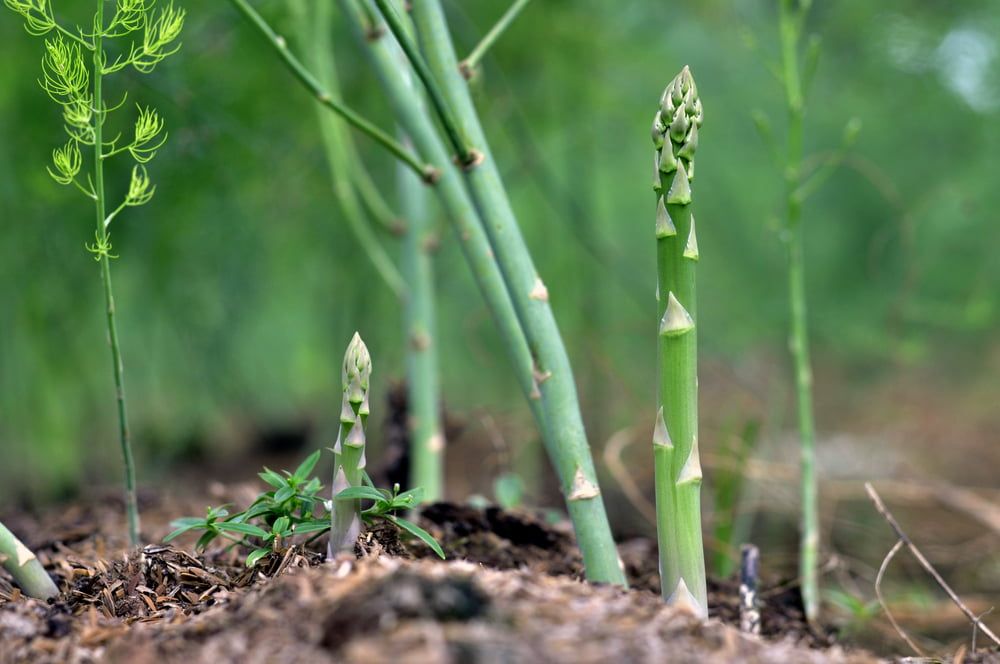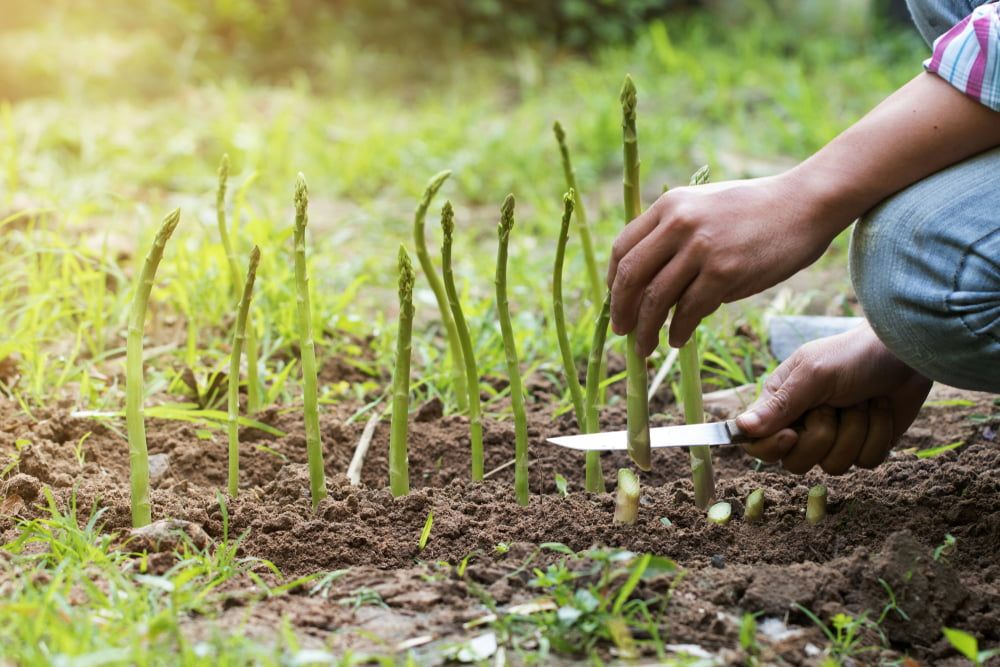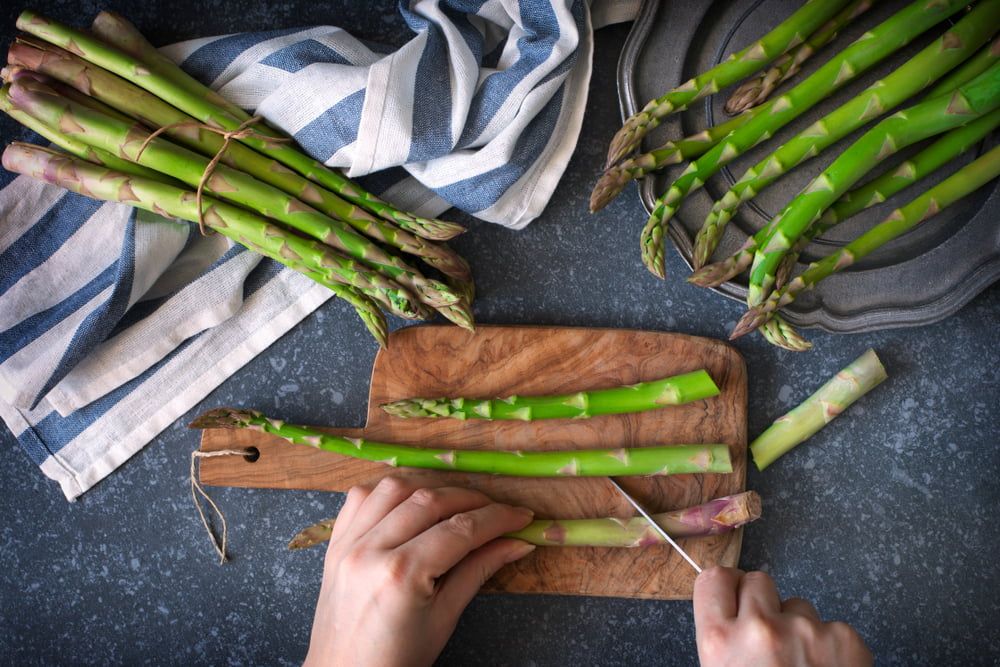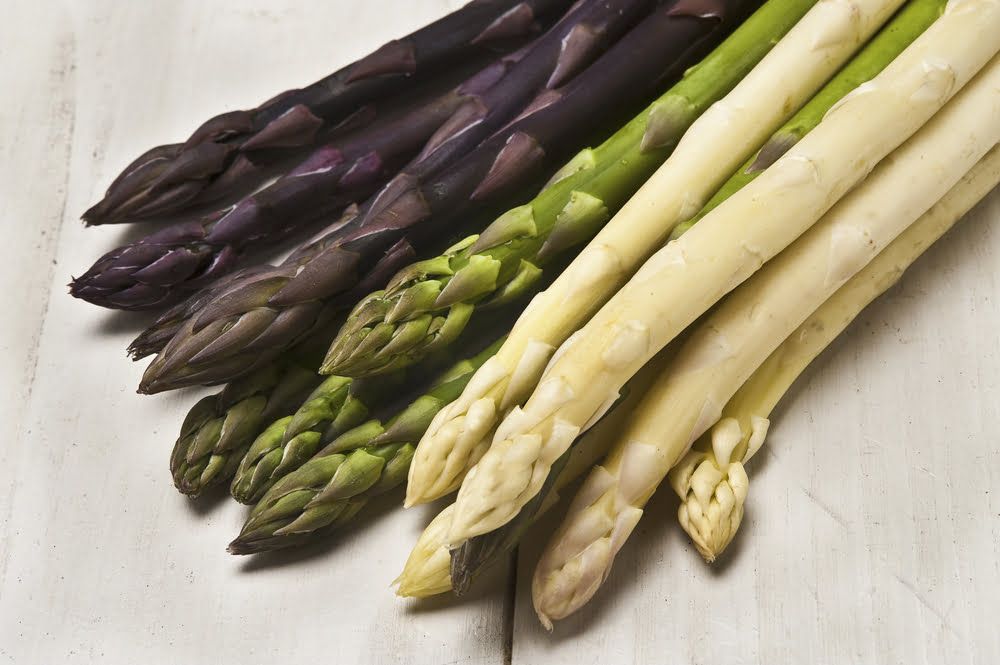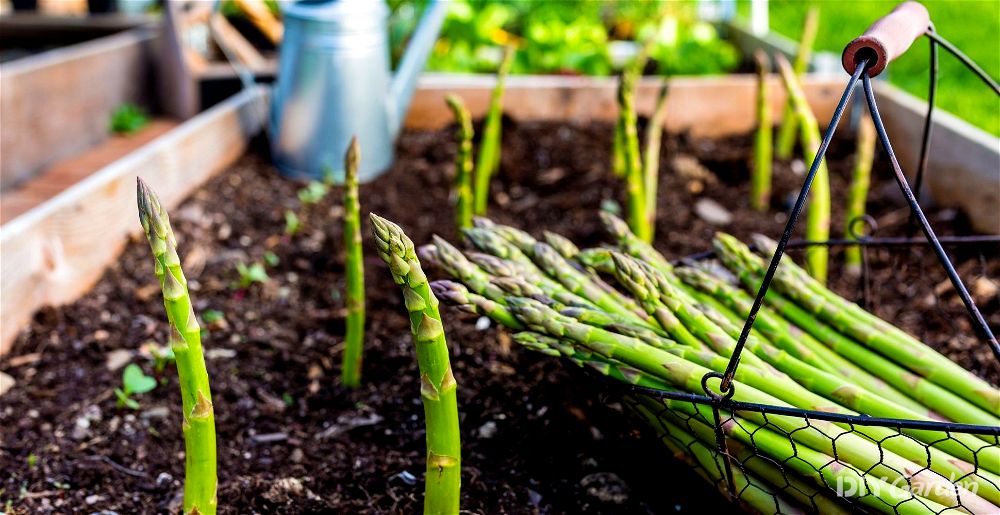
How to Grow Your Own Asparagus at Home
Growing asparagus in the UK can be incredibly rewarding. This perennial vegetable is known for its delicious spears and can produce a crop each spring for up to 20 years or more from the same plants. Here’s how to grow asparagus successfully in the UK:
1. Choose the Right Variety
- Opt for varieties that are well-suited to the UK climate, such as ‘Gijnlim’ (early season), ‘Backlim’ (mid-season), or ‘Purple Passion’ (for purple spears).
2. Prepare the Site and Soil
- Asparagus prefers a sunny, sheltered spot with well-drained soil. Avoid areas prone to waterlogging.
- Prepare the ground in autumn before planting. Clear weeds and dig in plenty of well-rotted manure or garden compost to enrich the soil.
- Asparagus thrives in neutral to slightly alkaline soil, so test your soil pH and adjust if necessary with garden lime.
3. Planting
- Asparagus can be grown from seed, but it’s more common and faster to plant one-year-old dormant plants known as crowns in early spring.
- Dig a trench about 30cm wide and 20cm deep. Create a mound in the bottom of the trench and spread the roots of each crown over these mounds, spacing them about 30-45cm apart. Cover with approximately 5cm of soil.
- As the plants grow, gradually fill in the trench with more soil.
4. Watering
- Water the newly planted crowns well and keep the area moist during dry periods. Asparagus needs consistent moisture, especially during the spear growth period in spring.
5. Feeding
- Apply a general-purpose fertiliser in early spring before the spears start to emerge and again after the harvest period to encourage fern growth, which feeds the crowns for the next year.
6. Mulching
- Apply a thick layer of mulch around the plants to retain moisture, suppress weeds, and protect the crowns during winter.
7. Cutting Back
- Do not harvest any spears in the first year and limit the harvest period to 4-6 weeks in the second year to allow the plants to establish.
- After the harvest period, allow the spears to develop into ferns, which photosynthesize and strengthen the crowns for the next season.
- Cut back the yellowed ferns in late autumn to reduce the risk of pests and diseases over winter.
8. Harvesting
- From the third year, you can begin harvesting spears from late April to June when they are about 15cm tall, using a sharp knife to cut them just above the soil level.
- Harvest spears every few days to prevent them from becoming woody.
9. Weed Control
- Keep the asparagus bed weed-free, as competition for nutrients can affect yield. Hand-weed carefully to avoid disturbing the shallow roots of the asparagus plants.
10. Pest and Disease Management
- Watch out for asparagus beetle, which can damage the spears and foliage. Pick off beetles by hand or use organic pesticides if necessary.
- Ensure good air circulation around the plants to prevent fungal diseases such as asparagus rust.
Growing Asparagus: A Quick Snapshot
When to Sow – Jan-Mar
When to Plant – June
When to Harvest – Apr
Average Yield per Plant – 0.25kg
Spacing – 45cm
Depth – 20-30cm
How to Grow Asparagus at Home
It may be one of the most well-balanced and nutrient-rich vegetables out there, but asparagus also has a reputation of being labour-intensive.
In a way, this is true. Your asparagus plants will require a fair bit of time and attention to start with, but, once they get going, they’re pretty much maintenance-free. Your efforts at the beginning will pay off big style – not only will growing your own asparagus save you money, but it’s also guaranteed to taste so much better than anything you could buy from a shop.
Growing Asparagus: Seeds vs Crowns
There are two ways in which you can begin growing asparagus at home; you can either start them from seed or plant asparagus crowns. These are basically bare-root asparagus plants that are already one or two years old.
Planting mature crowns gives you a head start on the growing process. Starting asparagus from seed can also be quite time-consuming – something you’ll be able to avoid if you go for crowns.
However, asparagus crowns are significantly more expensive than asparagus seeds. On a very small scale, this might not matter so much. However, since each plant only produces about 8-15 spears a season, it’s recommended that you plant between 10 and 20 asparagus plants per person, depending on how much asparagus you plan on eating. This can really add up, making seeds the more cost-effective option.
Preparing Asparagus Planting Beds
Asparagus needs soil that’s rich and fertile, but also very well-draining. It can sometimes be necessary to begin preparing your future asparagus beds well in advance of planting, even before you’ve sown any seeds.
Choose a location that receives full sun, but is as protected as possible from strong winds.
Begin by completely weeding the area. While a small number of weeds can be tolerated in later years, young asparagus plants need a weed-free environment in order to properly set their roots.
You will then need to amend your soil with either quality compost or well-rotted animal manure. One option is to dig this in, but you could also go with the no-dig method – simply place all of that good stuff over the top of your soil, and allow nature to incorporate it in for you.
The earlier you can do all of this, the better – the autumn before planting would be perfect. However, you may also want to throw an organic mulch over the top, to prevent any weeds from popping up before you’re ready to plant your asparagus.
How to Grow Asparagus from Seed
Asparagus seeds should be started early in the year – January to early March is best. The reason for this is because asparagus seeds can take a while to germinate – expect anywhere between 2-10 weeks.
Ideally, you want to be able to plant your asparagus out once all risk of frost has passed. The long germination window can make it tricky to get timings right, so aim to sow 8-10 weeks before your last frost.
To give your asparagus the best possible start to life, start your seeds individually in 7cm pots.
Fill your pots with a fertile compost and then water. Place a seed over the top of the soil in each pot, before covering over with a light layer of compost – you want the seeds to be about 1cm deep.
Lightly water and then place on a heated seedling mat or in a heated propagator. Asparagus seeds germinate best when given consistent temperatures between 24-30ºC.
They will germinate at lower temperatures too, but make sure that you never allow soil temperatures to drop below 10ºC – this will prevent sprouting. Likewise, never allow temperatures to go above 35ºC.
Keep your asparagus consistently moist during germination, as well as once your seedlings emerge.
You will need to care for them in this way for the next 10-12 weeks, until they are old enough to be planted out.
How to Plant Asparagus Outside
Before planting your asparagus outside, you’ll need to harden it off:
How to Harden Off Asparagus Plants
Young asparagus plants are known for being pretty sensitive. Extreme temperature and environment changes, such as moving from a heated indoor location to the chilly air and bitter winds outdoors, can quickly cause transplant shock. This will soon kill the plant.
Hardening your asparagus plants off gives them time to acclimate to their new environment.
Simply place your potted plants outdoors for an hour on a dry and sunny day, before bringing them back in. Slowly build up the amount of time you leave them outside for each day, over the course of two weeks. Once they have spent all day, and maybe even all night, outside, then they’re ready to be planted out.
Planting Asparagus
When planting asparagus, some people like to dig trenches while others like to dig holes. Choose whichever method works best for you.
Either way, your trench/holes should be about 20-30cm deep, and holes should be about 30cm apart (this is also how far apart each of your asparagus plants will need to be if planting into a trench).
Place your plants into their new homes, gently spreading the roots out as much as possible. Cover over with soil, gently firm down, and then water well.
Check your newly-planted asparagus each week. As the crowns grow, you may need to add in more soil to cover them over. Don’t worry if you end up with small mounds – this will settle over time.
How to Plant Asparagus in a Greenhouse
Growing asparagus in a greenhouse has its pros and cons.
The biggest difficulty is temperature regulation – once you’ve planted your asparagus, you don’t want temperatures to get much warmer than 25ºC.
However, if you can keep temperatures consistent, you’ll likely experience a larger and tastier harvest. A greenhouse allows for warm temperatures earlier in the spring, which gives young spears a good growth spurt. A greenhouse will also protect tender young spears from strong winds, saving them from snapping.
The steps for planting asparagus in a greenhouse are the same as when planting outside. This applies to those with raised beds in their greenhouse too.
If you’re considering growing asparagus in a container, you may want to rethink this. Asparagus, especially when grown in a greenhouse, can reach up to 2.75m in height, with a spread of about 1m.
Most containers simply aren’t large enough to accommodate a plant of this size, especially if you want a considerable harvest out of it. If you have a big enough container, then it’s worth a try, but your yields will be much smaller than asparagus that has been given more space.
How to Care for Asparagus
Once established, asparagus plants will generally look after themselves. However, they will need some extra care in order to reach that stage:
Watering Asparagus
Asparagus comes from boggy and swampy areas – it likes consistent moisture. Ideally, asparagus needs about 2.5cm of water a week.
It’s important that you keep an eye on this – asparagus won’t show signs of being thirsty until it’s too late. Each week, check that the top 8cm of soil is moist. Don’t do this too near to your asparagus plants, as you don’t want to risk damaging those shallow roots as you delve downwards. If the soil feels dry, your asparagus needs water.
Weeding Asparagus
As mentioned, asparagus hates competing with weeds. Even if you’ve already weeded and mulched your planting bed, you’ll need to keep checking it for weeds.
Once you spot some, these will need to be pulled up by hand. Even a small garden tool could damage shallow asparagus roots, so hand-weeding is always the recommended method.
This may be time-consuming and labour-intensive at first, but stay on top of the weeds, as well as the mulching, and there won’t be much weeding to do after a while.
Cutting Back and Mulching Asparagus
In the autumn, the foliage on your asparagus plants will start to turn yellow.
Once the leaves have fully dried and turned brown, you should cut them back to about 2.5cm above the ground. Don’t be tempted to cut them back too soon – the foliage is what feeds the crowns below the ground. Cutting this away too early will lead to very skinny spears the following season.
At this stage, you can then apply a thick layer of mulch to your planting bed to protect the crowns over the winter.
Fertilising Asparagus
Although not a must if both your planting bed and your mulch are nutrient-rich, fertilising your asparagus will give you a stronger and larger yield.
Asparagus should be fertilised in the spring. This should be done just before the first spears start to emerge, using a balanced, general-purpose mix.
Once you start harvesting your plants, you can then give them another dose of feed immediately after harvesting. However, this time, go with a nitrogen-heavy mix.
How to Harvest Asparagus
The biggest question on every new asparagus-grower’s mind is: when can I start harvesting my asparagus?
If you planted crowns, you can enjoy a small and careful harvest in the second year after planting, with full harvests beginning in year three.
As mentioned, growing from seed sets you back in the timeline. Your first small harvest should be in the third year after planting, with full harvests starting in year four.
You will still see spears appearing in early years, but make sure that you resist the temptation to harvest them until your plants are strong enough to keep producing more.
Once you’re ready to harvest and your spears are at least 15cm tall (which usually happens in May), simply grab a sharp knife or a pair of scissors and cut the spears at ground level.
If this is your first harvest, don’t overdo it. Harvest thick spears for about two weeks, and then stop. For everyone else, continue harvesting until new spears are much thinner – about the size of a pencil. This usually happens in July.
How to Store Asparagus
The easiest way to store fresh asparagus is to place the spears in the fridge. They’ll keep for about a week.
For long-term storage, freezing is your best option. Blanching before freezing is always advised – this is to preserve the colour and texture of the spears. However, if this isn’t something that bothers you, then go ahead and freeze raw spears.
When kept in the freezer, asparagus will be good to use for about a year.
Asparagus also pickles very well. When properly canned, jars will store for at least a year.
How to Prepare & Cook Asparagus
The base of each asparagus spear will be quite woody, making it unpalatable. Either cut each spear about 3-5cm from the bottom, or bend them in this area until they snap. The point where each spear naturally breaks separates the woody end from the tender top.
You then have the option of peeling the bottom half of each spear. This exposes the more tender parts within, while also speeding up cooking time. You don’t need to peel the top half of each spear, since this will already be very tender.
For the best flavour and texture, cook your asparagus as soon as you’re done with prep.
Cooking with Asparagus
Asparagus is surprisingly versatile, lending itself well to just about every cooking technique:
- Blanched – try serving this with lemon, garlic, and cayenne
- Grilled – season with salt, pepper, and oil before grilling
- Pan-fried – with garlic butter
- Roasted/baked – season with sea salt, olive oil, and parmesan cheese, or wrap some bacon around your spears
- Steamed – serve with lemon and garlic
Common Asparagus Problems
One of the most common problems that people have when growing asparagus is weak and spindly growth. This can be caused by a number of different factors:
- Harvesting too much the previous season – leave your asparagus to rest for a year before harvesting again
- Too much competition from weeds – increase how often you weed your asparagus, and apply a mulch too
- Not enough water – increase how often you water your asparagus. Mulches can help with this as well
- Pest damage – work out which pest is causing the damage, so that you can follow the right control methods
Speaking of pests, one of the most problematic is the asparagus beetle. These yellow, red, and black beetles feed on foliage, which weakens, and sometimes even kills, the plant. Small infestations can be manually picked off, but you may need to use a spray, whether chemical or organic, if you’re dealing with larger numbers.
In terms of diseases, the main one to look out for is asparagus rust. This occurs in high humidity conditions, producing orange pustules and yellowing foliage on asparagus plants. You will need to immediately remove infected foliage, give your plants a dusting of sulphur, and then be extra careful not to give your plants either too much or too little water.
Popular Asparagus Varieties to Grow
Some of the best asparagus varieties to grow are:
- Stewarts Purple – known for being sweeter and more tender than most green varieties
- Mondeo – resistant to many diseases and produces spears early in the season
- Precoce D’Argenteuil – a very sweet variety that has beautiful pink tips
- Pacific 2000 – a later-cropping variety that’s loved for its intense flavour
- Martha Washington – has a longer cropping season than other varieties with spears that freeze well
Conclusion
If you enjoy eating asparagus, then growing your own is definitely worthwhile. The biggest downside is the amount of space it requires, but, other than that, your asparagus harvests will only get larger and more prolific each year, making this a crop that you won’t regret planting.
